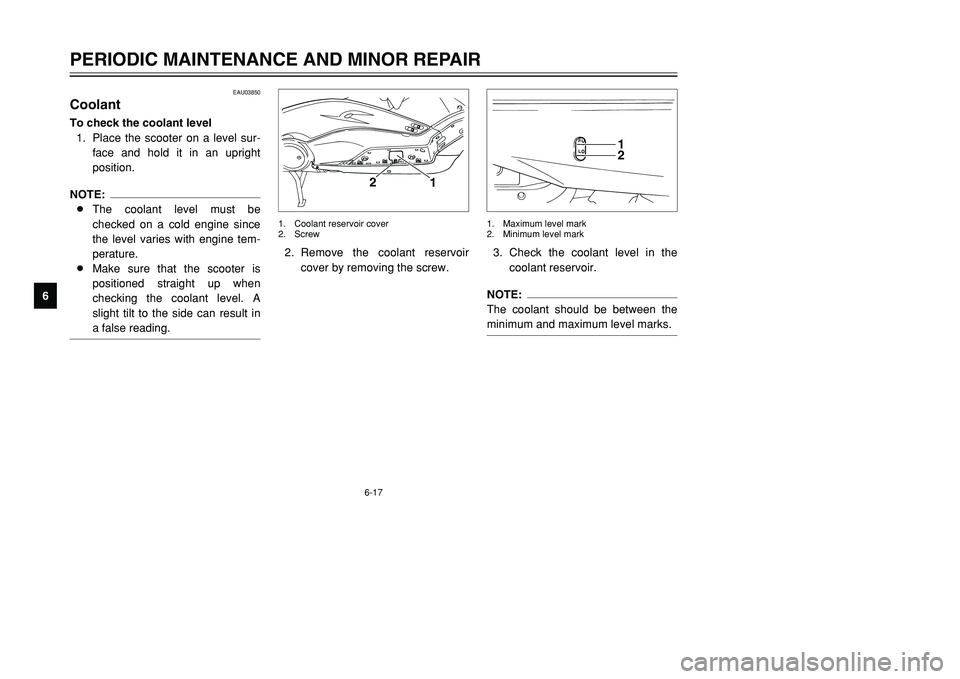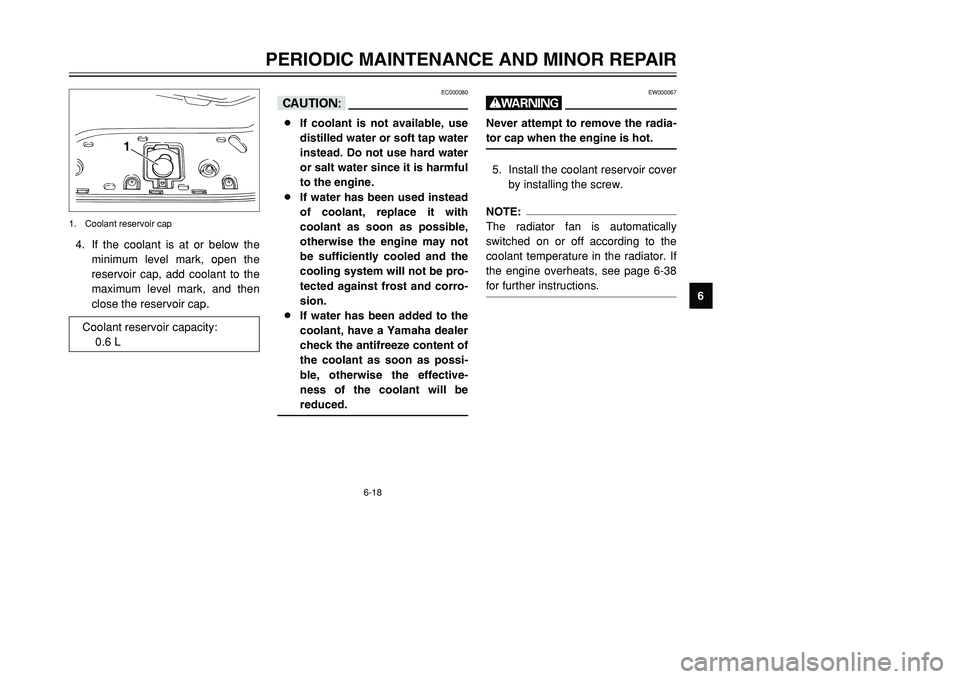YAMAHA TMAX 2002 Repair Manual
Manufacturer: YAMAHA, Model Year: 2002, Model line: TMAX, Model: YAMAHA TMAX 2002Pages: 102, PDF Size: 1.67 MB
Page 61 of 102

6-17
PERIODIC MAINTENANCE AND MINOR REPAIR
6
EAU03850
CoolantCoolantTo check the coolant level
1. Place the scooter on a level sur-
face and hold it in an upright
position.NOTE:
8The coolant level must be
checked on a cold engine since
the level varies with engine tem-
perature.
8Make sure that the scooter is
positioned straight up when
checking the coolant level. A
slight tilt to the side can result in
a false reading.
3. Check the coolant level in the
coolant reservoir.NOTE:
The coolant should be between the
minimum and maximum level marks.
12
1. Maximum level mark
2. Minimum level mark
2. Remove the coolant reservoir
cover by removing the screw.
1
2
1. Coolant reservoir cover
2. Screw
5GJ-9-E1 9/4/01 1:27 PM Page 60
Page 62 of 102

6-18
PERIODIC MAINTENANCE AND MINOR REPAIR
6 4. If the coolant is at or below the
minimum level mark, open the
reservoir cap, add coolant to the
maximum level mark, and then
close the reservoir cap.
1
1. Coolant reservoir cap
EW000067
wNever attempt to remove the radia-
tor cap when the engine is hot.5. Install the coolant reservoir cover
by installing the screw.NOTE:
The radiator fan is automatically
switched on or off according to the
coolant temperature in the radiator. If
the engine overheats, see page 6-38
for further instructions.
EC000080
cC8If coolant is not available, use
distilled water or soft tap water
instead. Do not use hard water
or salt water since it is harmful
to the engine.
8If water has been used instead
of coolant, replace it with
coolant as soon as possible,
otherwise the engine may not
be sufficiently cooled and the
cooling system will not be pro-
tected against frost and corro-
sion.
8If water has been added to the
coolant, have a Yamaha dealer
check the antifreeze content of
the coolant as soon as possi-
ble, otherwise the effective-
ness of the coolant will be
reduced.
Coolant reservoir capacity:
0.6 L
5GJ-9-E1 9/4/01 1:27 PM Page 61
Page 63 of 102

6-19
PERIODIC MAINTENANCE AND MINOR REPAIR
6
EAU03877
Cleaning the air filter
elementAir filter element, cleaningThe air filter element should be
cleaned at the intervals specified in
the periodic maintenance and lubrica-
tion chart. Clean the air filter element
more frequently if you are riding in
unusually wet or dusty areas.
1. Remove cowling A. (See page
6-8 for cowling removal and
installation procedures.)3. Remove the air filter case cover
by removing the screws, and
then pull the air filter element
out.
1
2
2
1. Air filter case cover
2. Screw (×4)
2. Remove the windshield by
removing the screws.1
1
1. Screw (×5)
5GJ-9-E1 9/4/01 1:27 PM Page 62
Page 64 of 102

6-20
PERIODIC MAINTENANCE AND MINOR REPAIR
6
1
1. Air filter element
EC000082
cC8Make sure that the air filter ele-
ment is properly seated in the
air filter case.
8The engine should never be
operated without the air filter
element installed, otherwise
the pistons and/or cylinders
may become excessively
worn.6. Install the air filter case cover by
installing the screws.
7. Install the windshield and the
cowling. 4. Lightly tap the air filter element to
remove most of the dust and dirt,
and then blow the remaining dirt
out with compressed air as
shown. If the air filter element is
damaged, replace it.
5. Insert the air filter element into
the air filter case.
5GJ-9-E1 9/4/01 1:27 PM Page 63
Page 65 of 102

6-21
PERIODIC MAINTENANCE AND MINOR REPAIR
6
EAU00630
Adjusting the carburetorsCarburetors, adjustingThe carburetors are important parts
of the engine and require very
sophisticated adjustment. Therefore,
most carburetor adjustments should
be left to a Yamaha dealer, who has
the necessary professional knowl-
edge and experience. The adjust-
ment described in the following sec-
tion, however, may be serviced by
the owner as part of routine mainte-
nance.
EC000095
cCThe carburetors have been set and
extensively tested at the Yamaha
factory. Changing these settings
without sufficient technical knowl-
edge may result in poor perfor-
mance of or damage to the engine.
NOTE:
The engine is warm when it quickly
responds to the throttle.4. Check the engine idling speed
and, if necessary, adjust it to
specification by turning the throt-
tle stop screw. To increase the
engine idling speed, turn the
screw in direction a. To
decrease the engine idling
speed, turn the screw in direction
b.
1a
b
1. Throttle stop screw
EAU03821
Adjusting the engine idling
speedEngine idling speedThe engine idling speed must be
checked and, if necessary, adjusted
as follows at the intervals specified in
the periodic maintenance and lubrica-
tion chart.NOTE:
A diagnostic tachometer is needed to
make this adjustment.1. Remove panel B. (See page 6-7
for panel removal and installation
procedures.)
2. Attach the tachometer to the
spark plug lead.
3. Start the engine and warm it up
for several minutes at 1,000–
2,000 r/min while occasionally
revving it to 4,000–5,000 r/min.
Engine idling speed:
1,150–1,200 r/min
5GJ-9-E1 9/4/01 1:27 PM Page 64
Page 66 of 102

6-22
PERIODIC MAINTENANCE AND MINOR REPAIR
6
NOTE:
If the specified idling speed cannot
be obtained as described above,
have a Yamaha dealer make the
adjustment.5. Install the panel.
EAU00637
Adjusting the valve
clearanceValve clearance, adjustingThe valve clearance changes with
use, resulting in improper air-fuel mix-
ture and/or engine noise. To prevent
this from occurring, the valve clear-
ance must be adjusted by a Yamaha
dealer at the intervals specified in the
periodic maintenance and lubrication
chart.
EAU00635
Adjusting the throttle cable
free playThrottle cable free play, adjustingThe throttle cable free play should
measure 3–5 mm at the throttle grip.
Periodically check the throttle cable
free play and, if necessary, have a
Yamaha dealer adjust it.
a
a. Throttle cable free play
5GJ-9-E1 9/4/01 1:27 PM Page 65
Page 67 of 102

6-23
PERIODIC MAINTENANCE AND MINOR REPAIR
6
EAU04403
TiresTiresTo maximize the performance, dura-
bility, and safe operation of your
scooter, note the following points
regarding the specified tires.
Tire air pressure
The tire air pressure should be
checked and, if necessary, adjusted
before each ride.
EW000082
w8The tire air pressure must be
checked and adjusted on cold
tires (i.e., when the tempera-
ture of the tires equals the
ambient temperature).
8The tire air pressure must be
adjusted in accordance with
the riding speed and with the
total weight of rider, passen-
ger, cargo, and accessories
approved for this model.
EWA00040
wBecause loading has an enormous
impact on the handling, braking,
performance and safety character-
istics of your scooter, you should
keep the following precautions in
mind.
8NEVER OVERLOAD THE
SCOOTER! Operation of an
overloaded scooter may result
in tire damage, loss of control,
or severe injury. Make sure
that the total weight of rider,
passenger, cargo, and acces-sories does not exceed the
specified maximum load for
the vehicle.
8Do not carry along loosely
packed items, which can shift
during a ride.
8Securely pack the heaviest
items close to the center of the
scooter and distribute the
weight evenly on both sides.
8Adjust the tire air pressure
with regard to the load.
8Check the tire condition and
air pressure before each ride.
Tire air pressure
(measured on cold tires)
Load* Front Rear
Up to 90 kg200 kPa
(2.00 kgf/cm
2,
2.00 bar)225 kPa
(2.25 kgf/cm
2,
2.25 bar)
90 kg–
maximum225 kPa
(2.25 kgf/cm
2,
2.25 bar)250 kPa
(2.50 kgf/cm
2,
2.50 bar)
Maximum load* 183 kg
* Total weight of rider, passenger, cargo and
accessories
5GJ-9-E1 9/4/01 1:27 PM Page 66
Page 68 of 102

6-24
PERIODIC MAINTENANCE AND MINOR REPAIR
6 Tire inspection
The tires must be checked before
each ride. If the center tread depth
reaches the specified limit, if the tire
has a nail or glass fragments in it, or
if the sidewall is cracked, have a
Yamaha dealer replace the tire imme-
diately.
NOTE:
The tire tread depth limits may differ
from country to country. Always com-
ply with the local regulations.
Tire information
This scooter is equipped with cast
wheels and tubeless tires.
EW000078
w8The front and rear tires should
be of the same make and
design, otherwise the handling
characteristics of the scooter
cannot be guaranteed.
8After extensive tests, only the
tires listed below have been
approved for this model by
Yamaha Motor Co., Ltd.
EAU00683
w8Have a Yamaha dealer replace
excessively worn tires.
Besides being illegal, operat-
ing the scooter with exces-
sively worn tires decreases
riding stability and can lead to
loss of control.
8The replacement of all wheel-
and brake-related parts,
including the tires, should be
left to a Yamaha dealer, who
has the necessary profession-
al knowledge and experience.
1a
1. Tire sidewall
a. Tire tread depthMinimum tire tread depth
(front and rear)1.6 mm
FRONT
Manufacturer Size Model
DUNLOP 120/70-14M/C 55S D305FABRIDGESTONE
120/70-14M/C 55S HOOP B03
REAR
Manufacturer Size Model
DUNLOP 150/70-14M/C 66S D305
BRIDGESTONE
150/70-14M/C 66S HOOP B02
5GJ-9-E1 9/4/01 1:27 PM Page 67
Page 69 of 102

6-25
PERIODIC MAINTENANCE AND MINOR REPAIR
6
EAU03773
Cast wheelsWheelsTo maximize the performance, dura-
bility, and safe operation of your
scooter, note the following points
regarding the specified wheels.
8The wheel rims should be
checked for cracks, bends or
warpage before each ride. If any
damage is found, have a
Yamaha dealer replace the
wheel. Do not attempt even the
smallest repair to the wheel. A
deformed or cracked wheel must
be replaced.
8The wheel should be balanced
whenever either the tire or wheel
has been changed or replaced.
An unbalanced wheel can result
in poor performance, adverse
handling characteristics, and a
shortened tire life.8Ride at moderate speeds after
changing a tire since the tire sur-
face must first be “broken in” for
it to develop its optimal charac-
teristics.
EAU03851
Front and rear brake leversFront and rear brake leversThere should be no free play at the
brake lever ends. If there is free play,
have a Yamaha dealer inspect the
brake system.FRONT
5GJ-9-E1 9/4/01 1:27 PM Page 68
Page 70 of 102

6-26
PERIODIC MAINTENANCE AND MINOR REPAIR
6
EAU00721
Checking the front and rear
brake padsFront and rear brake pads, checkingThe front and rear brake pads must
be checked for wear at the intervals
specified in the periodic maintenance
and lubrication chart.
EAU03938
Front brake pads
Each front brake pad is provided with
wear indicator grooves, which allow
you to check the brake pad wear
without having to disassemble the
brake. To check the brake pad wear,
check the wear indicator grooves. If a
brake pad has worn to the point that
the wear indicator grooves have
almost disappeared, have a Yamaha
dealer replace the brake pads as a
set.
1 11 1
1. Brake pad wear indicator groove (×3)
REAR
FRONT
5GJ-9-E1 9/4/01 1:27 PM Page 69